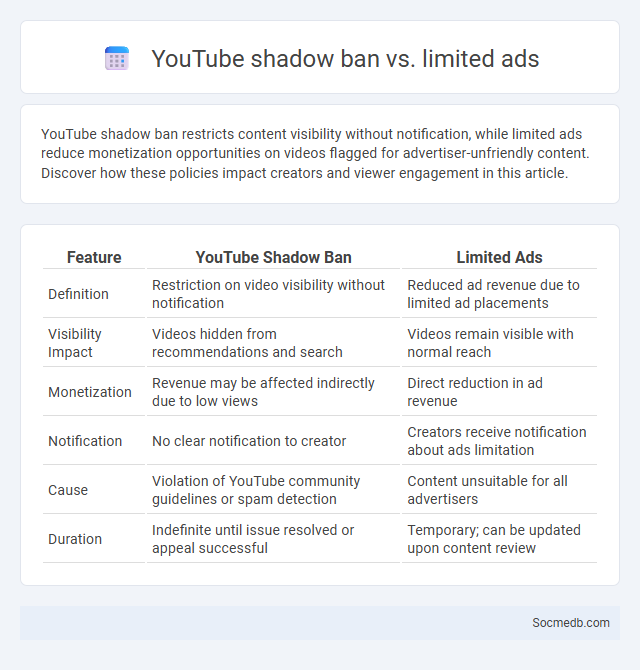
Photo illustration: YouTube shadow ban vs limited ads
YouTube shadow ban restricts content visibility without notification, while limited ads reduce monetization opportunities on videos flagged for advertiser-unfriendly content. Discover how these policies impact creators and viewer engagement in this article.
Table of Comparison
| Feature | YouTube Shadow Ban | Limited Ads |
|---|---|---|
| Definition | Restriction on video visibility without notification | Reduced ad revenue due to limited ad placements |
| Visibility Impact | Videos hidden from recommendations and search | Videos remain visible with normal reach |
| Monetization | Revenue may be affected indirectly due to low views | Direct reduction in ad revenue |
| Notification | No clear notification to creator | Creators receive notification about ads limitation |
| Cause | Violation of YouTube community guidelines or spam detection | Content unsuitable for all advertisers |
| Duration | Indefinite until issue resolved or appeal successful | Temporary; can be updated upon content review |
Introduction to YouTube Content Restrictions
YouTube content restrictions are guidelines that regulate what users can upload to maintain a safe and respectful platform environment. These rules prohibit content involving hate speech, violent or graphic material, nudity, and misinformation to protect diverse audiences and comply with legal standards. Creators must understand and adhere to these restrictions to avoid video removal, channel strikes, or demonetization.
What is YouTube Shadow Banning?
YouTube shadow banning is a practice where a user's content is hidden or restricted without their knowledge, reducing visibility in searches and recommendations. This limits audience reach and engagement without notifying the creator, often seen as a measure to control spam or inappropriate content. Shadow banning on YouTube affects video discoverability and subscriber growth, impacting content creators' overall channel performance.
Understanding Limited Ads on YouTube
Limited Ads on YouTube affect the reach and monetization potential of videos by restricting certain ad placements based on content suitability guidelines. Understanding these restrictions helps YouTubers optimize their content for better ad compatibility and audience engagement. Your content strategy should align with YouTube's advertiser-friendly policies to maximize revenue opportunities and maintain channel growth.
Shadow Ban vs Limited Ads: Key Differences
Shadow ban restricts user content visibility on social media platforms without notifying the user, leading to reduced organic reach and engagement. Limited ads refer to a targeted reduction in the delivery of paid advertisements due to violations of advertising policies or low ad relevance scores. Understanding these distinctions helps marketers optimize content strategies and ensure compliance with platform guidelines to maintain audience reach.
How Shadow Banning Affects Content Visibility
Shadow banning reduces your content visibility by limiting its reach without notification, causing fewer people to see your posts in feeds and search results. Algorithms detect behaviors considered spammy or violating community guidelines, which triggers shadow bans and suppresses content distribution. As a result, your engagement drops significantly, making it harder to grow your audience organically.
Impact of Limited Ads on Monetization
Limited ads on social media platforms directly affect monetization by restricting revenue streams for content creators and advertisers. Reduced ad placements lead to fewer opportunities for You to generate income and diminish the platform's overall advertising performance metrics. This constraint pressures creators to diversify income sources beyond traditional ads to maintain financial sustainability.
Common Triggers for Shadow Banning
Common triggers for shadow banning on social media include the use of banned hashtags, posting spammy or repetitive content, and engaging in aggressive following or liking behaviors. Violations of community guidelines such as sharing misinformation, promoting hate speech, or using bots can also lead to restricted visibility. Algorithms often monitor user interactions, reported content, and activity patterns to identify accounts for shadow banning.
Signs You May Be Experiencing a Limited Ads Issue
Limited ads issues on social media often manifest through reduced ad reach, abnormal campaign performance, and sudden drops in engagement metrics such as click-through rates and conversions. You may notice frequent policy violation warnings or account restrictions even when adhering to guidelines, indicating potential hidden compliance problems or algorithmic flags. Monitoring your ad account health and reviewing platform-specific diagnostic tools can help identify and resolve underlying limitations affecting your advertising effectiveness.
Ways to Avoid Shadow Bans and Limited Ads
To avoid shadow bans on social media, consistently follow platform guidelines by posting original content and engaging genuinely with your audience while avoiding spammy behavior, such as excessive liking or commenting. Use diverse hashtags strategically, steering clear of banned or overused tags that trigger automated filters. For limited ads, ensure compliance with advertising policies, maintain transparent targeting practices, and regularly review ad performance metrics to promptly address any restrictions or disapprovals.
Conclusion: Navigating YouTube’s Content Policies
Navigating YouTube's content policies requires a clear understanding of its community guidelines, copyright rules, and monetization criteria to ensure your videos remain compliant and visible. Violations can result in video removal, strikes, or channel termination, making proactive adherence essential for sustained growth and audience trust. By staying informed and adapting your content strategy, you protect your channel's longevity while maximizing engagement and revenue opportunities.
 socmedb.com
socmedb.com